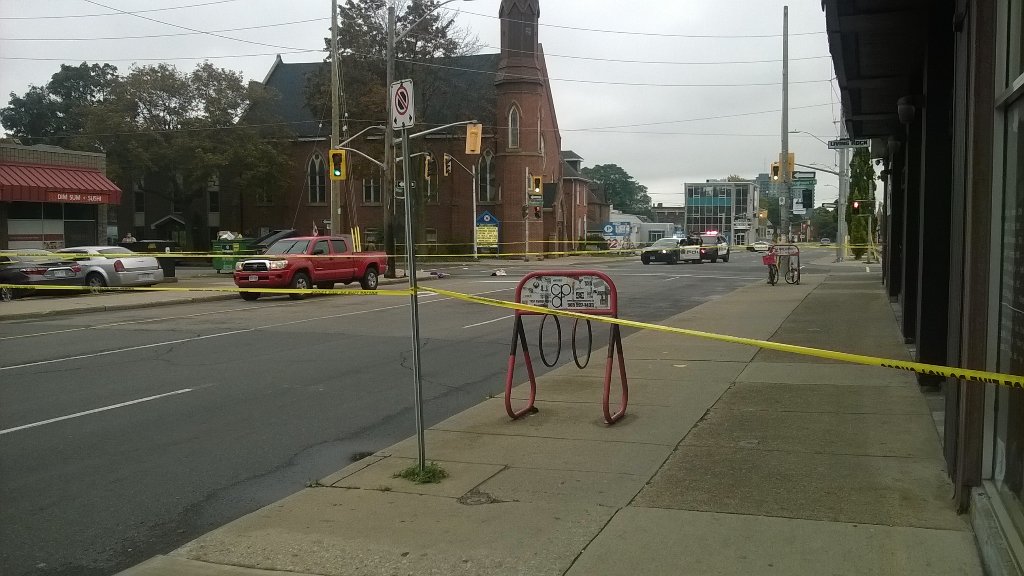New research by McMaster University researchers provides insights into how the City of Hamilton can decrease pedestrian violations of traffic regulations which result in collisions.
Department of Civil Engineering Ph.D. candidate Haniyeh Ghomi and Assistant Professor Dr. Mohamed Hussein used a Bayesian structural equation modelling framework to analyze Hamilton’s mid-block pedestrian collisions that occurred between 2010 and 2017 to “understand the impact of a variety of factors on the frequency and severity of pedestrian-vehicle collisions that involve pedestrian spatial violations at mid-blocks.”
They define spatial violations as people who cross outside of mid-block crosswalks within 30m of the crossing location or mid-block crossings “with no close-by marked crosswalks where pedestrians did not yield the right-of-way to vehicles.”
The data set provided to the researchers included 617 pedestrian-vehicle collisions reported at mid-block locations during the eight years.
Of the 617 collisions, 214 of these collisions (34.7 percent) “were mainly attributed to pedestrian violations.”
In these 214 collisions, the researchers write that 91.4 percent resulted in serious pedestrian injury or death. There were 11 fatalities and 192 injuries.
Decreasing and eliminating mid-block pedestrian collisions is important to achieving Vision Zero, the elimination of serious injuries and deaths involving vehicles.
One of the key findings of their analysis is that a large number of these collisions occur where both bike share stations and HSR bus stops are located mid-block.
“It is expected that many violations would occur at these locations, especially in situations such as a cyclist trying to park the bike and cross the street to catch an approaching bus,” they write. “Special attention is required when selecting the location of the bike-share stations, especially those that are close to bus stops.”
Mid-block pedestrian collisions are less severe near amenities such as schools, playgrounds, and access to trails. Pedestrian collisions near amenities are less likely to be fatal.
The researchers do not have speed data, they hypothesize these amenities are “usually located in reduced speed zones, and the vehicle operating speeds are typically low. Consequently, the severity of collisions is expected to be lower.” They note drivers usually pay more attention in areas with many pedestrians.
The City of Hamilton has also installed pedestrian crossing lights in many of these locations.
Mid-block pedestrian collisions are more likely to occur where there are refuge (centre) islands or a lower number of lanes, during dry weather conditions.
Research has shown pedestrians are less likely to cross mid-block on streets with more lanes or during inclement weather.
The analysis shows where countermeasures to prevent violations, which can include pedestrian crossing lights as an example, can be most effective.
In a map visualization, within the article behind an academic paywall, there are clusters of mid-block “violation” occurrences throughout Ward 3, along James Street North, many incidents along Bay Street North and Guise Street in areas of Bayfront Park to Pier 8, as well as many incidences along John Street South and James Street South between the Hamilton GO Centre and St. Joseph’s Hospital.
Since 2017, the City has installed new pedestrian lights in some of these locations.
The City of Hamilton does not provide collision data for analysis by journalists.
Past attempts to access the data using the Municipal Freedom of Information and Protection of Privacy Act have been unsuccessful because the City claims the data belongs to the Hamilton Police Service.
The Hamilton Police Service does not provide the data as it is controlled and retained by the City of Hamilton.
For those with academic paywall access, the original paper is here: https://journals.sagepub.com/doi/full/10.1177/03611981221097964
Production Details v. 1.0.1 Last edited: June 26, 2022 Author: Joey Coleman Edit Record v. 1.0.0 original version v. 1.0.1 correct typo, attempts to get the data were unsuccessful.

